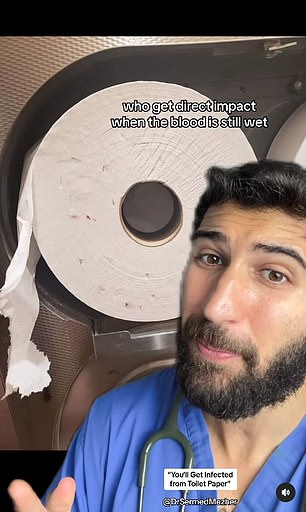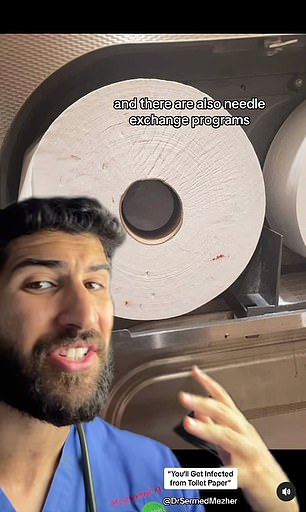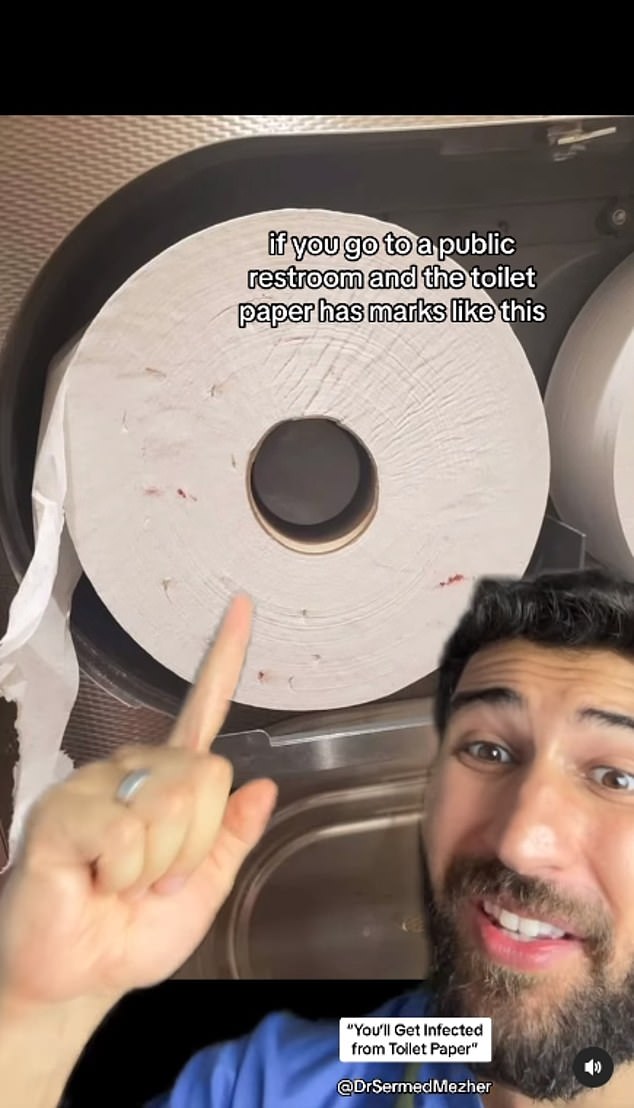Using some public toilets could put patients at risk of contracting a deadly virus, a UK doctor has warned.
Small red marks found on toilet paper could be traces of blood left by intravenous drug users when cleaning their needles.
Needles used to inject illegal drugs are often… contain blood that may be infected with pathogens, including hepatitis B, C, or even HIV.
A London-based doctor warned that this is a “possible” but “very rare” risk.
Dr Sermed MezherA locum GP who has more than 200,000 followers on TikTok said: ‘People have said the risk of transmission from using one of these is one in three for hepatitis and one in 300 for HIV.
Small red marks found on toilet paper could be traces of blood left behind by intravenous drug users cleaning their needles, said Dr. Sermed Mezher.
‘But that’s for health care workers who get hit directly when the blood is still wet.
“The risk of transmission if something has dried like this is significantly lower, but it is still possible.”
Experts have long warned that intravenous drug users may sometimes resort to improvised cleaning methods for their needles, such as wiping them with toilet paper or other available materials.
But the method is ineffective in properly sterilizing the needle, as wiping it with toilet paper does not remove or kill these viruses.
Instead, they can remain on the needle or expose people to indirect exposure by transferring to surfaces such as sinks, toilet seats or dispensers.
Dr Mezher added: ‘Of course, it is also incredibly rare for a drug user to want to do this, as it would be dulling their needle.
‘There are also needle exchange programs that can help you get clean needles for free.
“These drug rehabilitation programs are important not only to protect others but also ourselves.”
Other experts have warned that the risk of contracting HIV from toilet paper is virtually impossible.
Once outside the body, HIV “normally cannot survive for long,” warns the Terrence Higgins Trust.
“Contact with blood or semen that has been outside the body does not generally pose a risk of HIV transmission,” the charity said.
In another TikTok video, Harm Reduction Services, a California-based nonprofit, also warned that toilet paper was unlikely to be used to clean needles, given that “needles dull very quickly.”
They added: ‘If someone is cleaning needles for reuse… they will do so with a liquid, such as a bleach solution, so that the tip does not become cloudy.’
However, according to the World Health Organization (WHO), hepatitis is 50 to 100 times more infectious than HIV.
The hepatitis B virus can also survive outside the body for at least seven days, the UN agency says.
There are an estimated 105,200 people living with HIV in the UK, according to the National AIDS Trust.
But only 94 percent of these people are diagnosed.
This means that around 1 in 16 people living with HIV in the UK do not know they have the virus.


But according to Dr Mezher, the risk of transmission, while “possible”, remains “incredibly rare”. The locum GP, who has more than 200,000 followers on TikTok, said: “People have said the risk of transmission from using one of these is one in three for hepatitis and one in 300 for HIV.”
Treatment options have evolved considerably since HIV was first identified in the early 1980s; patients now take daily medications (antiretroviral therapies) to reduce the amount of virus in their blood to undetectable levels.
However, although these medications are effective, they are not a cure.
This has eluded scientists for decades because of the unique way the virus hijacks the body’s own cells.
HIV hides in the body’s immune cells, where viral cells can protect themselves from being destroyed.
This makes it difficult to find and eliminate HIV in the body, because there is also a risk of damaging healthy cells.
Hepatitis, of which there are multiple types, often has no noticeable symptoms.
But signs of infection include dark urine, pale gray stools, itchy skin, and yellowing of the eyes and skin.
People who are infected may also experience muscle and joint pain, high fever, feeling and being unusually sick and tired all the time, according to the NHS.
Experts warn, however, that living with hepatitis B “often subjects people to a stigma, meaning fewer people seek potentially life-saving treatments.”
The NHS has set itself the goal of eliminating another type of hepatitis, hepatitis C (hep C), by 2025, five years ahead of the WHO target.
In England, hepatitis C deaths have fallen by 35% in six years, far exceeding the 10% target. They are also at their lowest level in 20 years.


